



 The project is co-funded by the Regional Operational Programme of Lesser Poland for the years 2014 – 2020. The support of small and medium-sized enterprises which operate in tourism and increasing the recognisability of Lesser Poland as a tourist economic brand.
The project is co-funded by the Regional Operational Programme of Lesser Poland for the years 2014 – 2020. The support of small and medium-sized enterprises which operate in tourism and increasing the recognisability of Lesser Poland as a tourist economic brand.
How to get there?
e-podroznik.pl website would be of great assistance while planning organised transport
e-podroznik.pl
By bus
• CRACOW - PIWNICZNA-ZDRÓJ
szwagropol.pl
• KRYNICA-ZDRÓJ - ŻEGIESTÓW - PIWNICZNA-ZDRÓJ
rafatex.pl
• NOWY SĄCZ - PIWNICZNA-ZDRÓJ - ŁOMNICA-ZDRÓJ/WIERCHOMLA
marpol-bus.com.pl
By train
• CRACOW - TARNÓW - NOWY SĄCZ - PIWNICZNA-ZDRÓJ
rozklad-pkp.pl
Nearest airports
Cracow • Katowice • Rzeszów
CONTENTS
The project ‘The support of small and medium-sized enterprises which operate in tourism and increasing the recognisability of Lesser Poland as a tourist economic brand’ (no RPMP.03.03.01-12-0593/18) co-funded by the European Union as a part of the Regional Operational Programme of Lesser Poland for the years 2014 – 2020.
the Foundation for the Development of Regions www.f-rr.org
the Association of Polish Spa Communities www.sgurp.pl
Art Manager: Konrad Rogoziński

Text: Maria Kościelniak
Proofreading: Agata Kościelniak
Translation: Ewelina Natanek-Rogozińska
Design: Klaudia Stochmal, Nina Kieblesz
Realization: Digital Places Multimedia Publishing www.digitalplaces.pl
Kraszewskiego 1/406
33-380 Krynica-Zdrój
Typesetting Klaudia Stochmal, Nina Kieblesz
Photographies: © Konrad Rogoziński / DigitalPlaces.pl
Apart from:
P 7, photo no 3, p 11 photos no 7 i 8; p 16; p 19 photo no 3;
p 25 The green trail, p 29 photo no 6 © Wiktor Baron
P 8-9, photos no 1, 2, 3, 4, 5, 6; p 10-11 photos no 1, 2, 5, 6; p 14-15;
p 20-21 photos no 2 i 4; p 23 photos no 2 i 3, p 26 photo no 5;
p 27 photo no 8 © Mirosław Hobora
P 26-27, photos no 2 i 4 © Freepik.com

P 28-29, photos no 3 i 7 © Łukasz Świętach
P 27. photo no 4 © Adobe Stock
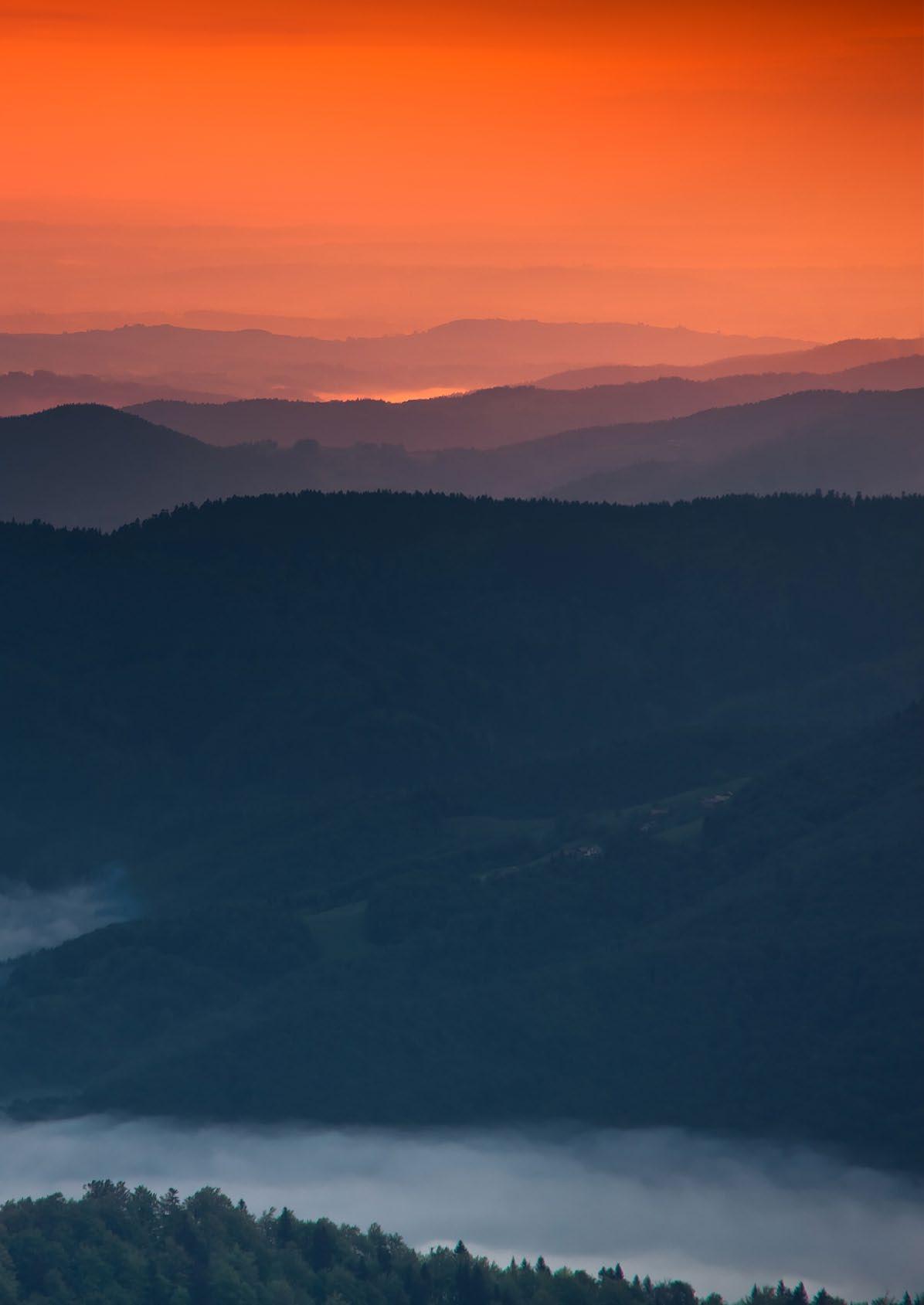
INTRODUCTION GENERAL INFORMATION LOCATION/GEOGRAPHY INTERESTING FACTS SPA HISTORY IN A NUTSHELL PIWNICZNA -ZDRÓJ VILLAGES BY THE POPRAD RIVER COMMUNE IN AN ACTIVE WAY ACTIVELY IN WINTER 02 04 06 08 12 16 19 22 24 28
Piwniczna-Zdrój

In the heart of the Carpathians
In the heart of the Polish Carpathians, in the picturesque valley of the Poprad Piwniczna-Zdrój commune is located. This small town together with neighbouring villages is tucked between the ranges of the Beskid Sądecki: the Jaworzyna Range, the Radziejowa Range and the Poprad Highlands. From the south the commune neighbours on Slovakia.

The pace of life in this place is different than anywhere else. The rhythm of life is regulated by seasons – winters and summers are more perceptible in the mountains than on lowlands. Springs mark the beginning of a new cycle in nature and autumns finish it. The settlements are dispersed in the valleys and on mountain slopes where nature is visible on every step. The region abounds in fir and spruce forests which almost peek at people from above. We can also come across larch and beech trees, however, not as often. Numerous mountain creeks and a diverse landform create an incredible, mountain climate and mineral water springs make the place an oasis for those who want to improve their health.

The history of Piwniczna and neighbouring villages dates back to the 14th century. We can listen to the stories about people from tens and hundreds of years ago on every step. On the square in Piwniczna-Zdrój there is a reconstructed well which reminds us about former inhabitants of the town, Węgielnik Mountain (498 m) hides war trenches, the Trail of War Couriers leads us to Eliaszówka (1,023 m).
The location in the mountains and the long history of the commune make it attractive to amateurs of nature, mountain challenges, spas or historic sites. The wildlife together with the wolf, the lynx and the bear is unique. Let us not forget about such curiosities as the mountain dragon or the fire salamander! The woods of the Beskid Sądecki hide amazing rocks, caves and waterfalls. Hiking or cycling tourists will find a lot of trails with panoramic spots and towers from which breathtaking views of the Beskids, the Gorce, the Tartas and the Pieniny spread. In the valleys there are mineral water pump rooms, historic sites and museums, Lemko Orthodox churches and many other attractions. piwniczna.pl
2
INTRODUCTION
Piwniczna-Zdrój
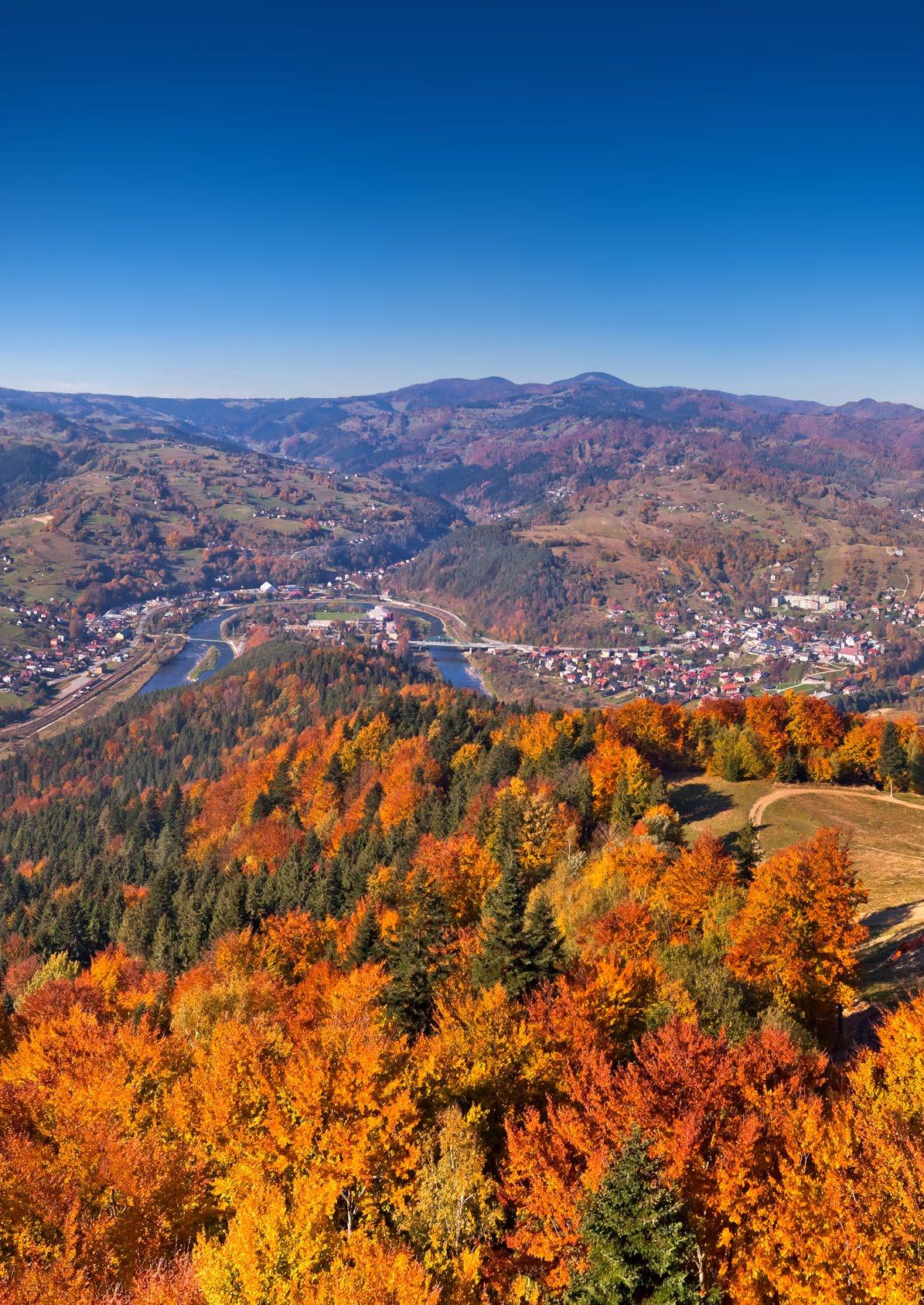
3
Voivodeship: Lesser Poland
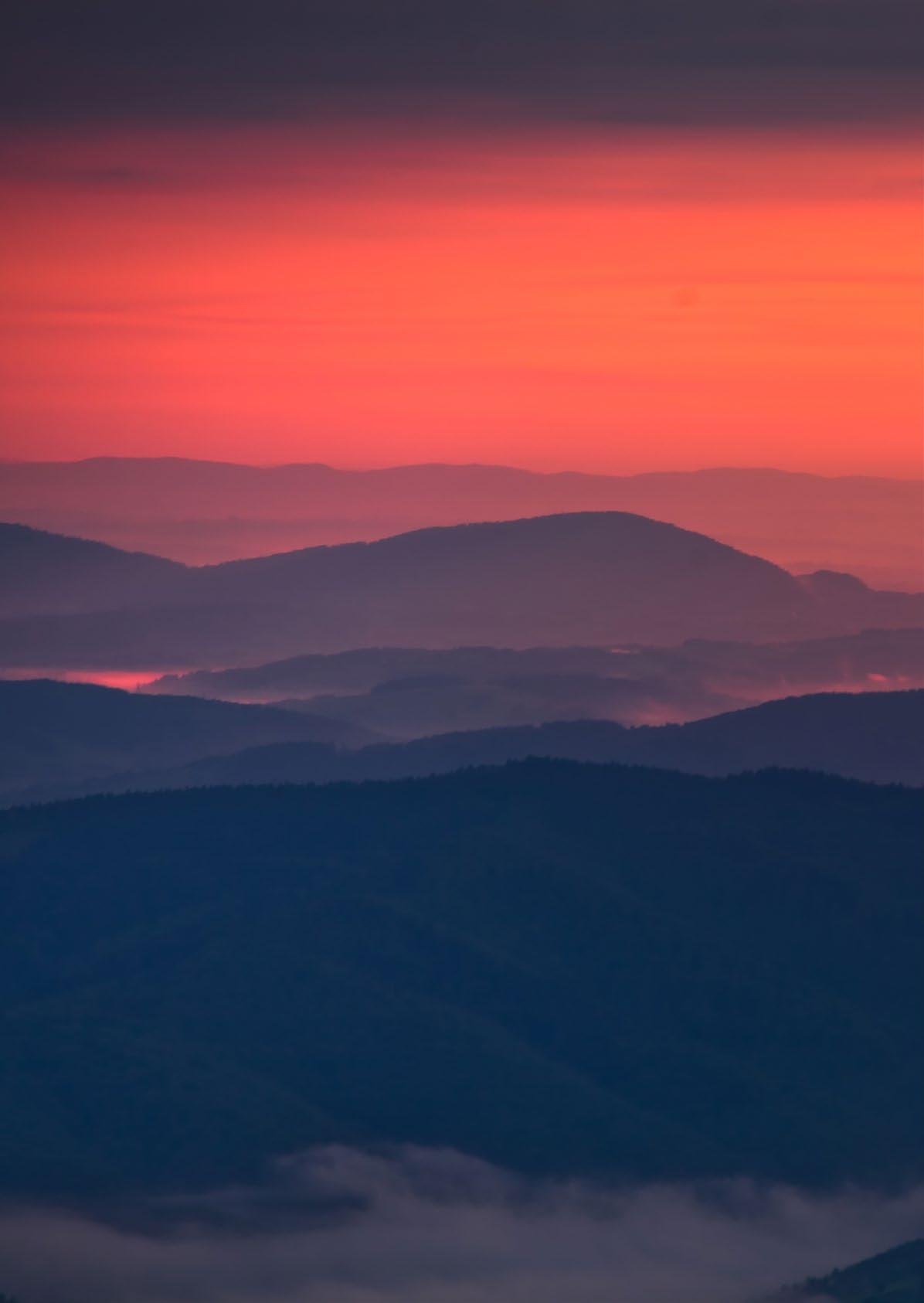
Poviat: Nowy Sącz
Seat: Piwniczna-Zdrój
Villages: Głębokie, Kokuszka, Łomnica-Zdrój, Młodów, Wierchomla Mała, Wierchomla Wielka, Zubrzyk
Neighbours on: Łabowa, Muszyna, Nawojowa, Rytro, Szczawnica
Communes and Slovakia from the south
Area: 126 km²
Population: 10 588
Spa status since: 1931
DISTANCE BETWEEN PIWNICZNA-ZDRÓJ AND OTHER VOIVODESHIP CITIES CITY TIME DISTANCE Białystok Bydgoszcz Gdańsk Gorzów Wielkopolski Katowice Kielce Cracow Lublin Łódź Olsztyn Opole Poznań Rzeszów Szczecin Warsaw Wrocław Zielona Góra 606 km 507 km 721 km 663 km 198 km 201 km 109 km 347 km 399 km 675 km 307 km 577 km 177 km 766 km 410 km 390 km 557 km 7 h 10 min 6 h 30 min 7 h 20 min 6 h 30 min 2 h 40 min 3 h 30 min 2 h 10 min 4 h 20 min 5 h 7 h 50 min 3 h 40 min 6 h 2 h 40 min 7 h 30 min 5 h 30 min 4 h 30 min 5 h 40 min 4 Piwniczna-Zdrój GENERAL INFORMATION
MAŁOPOLSKA


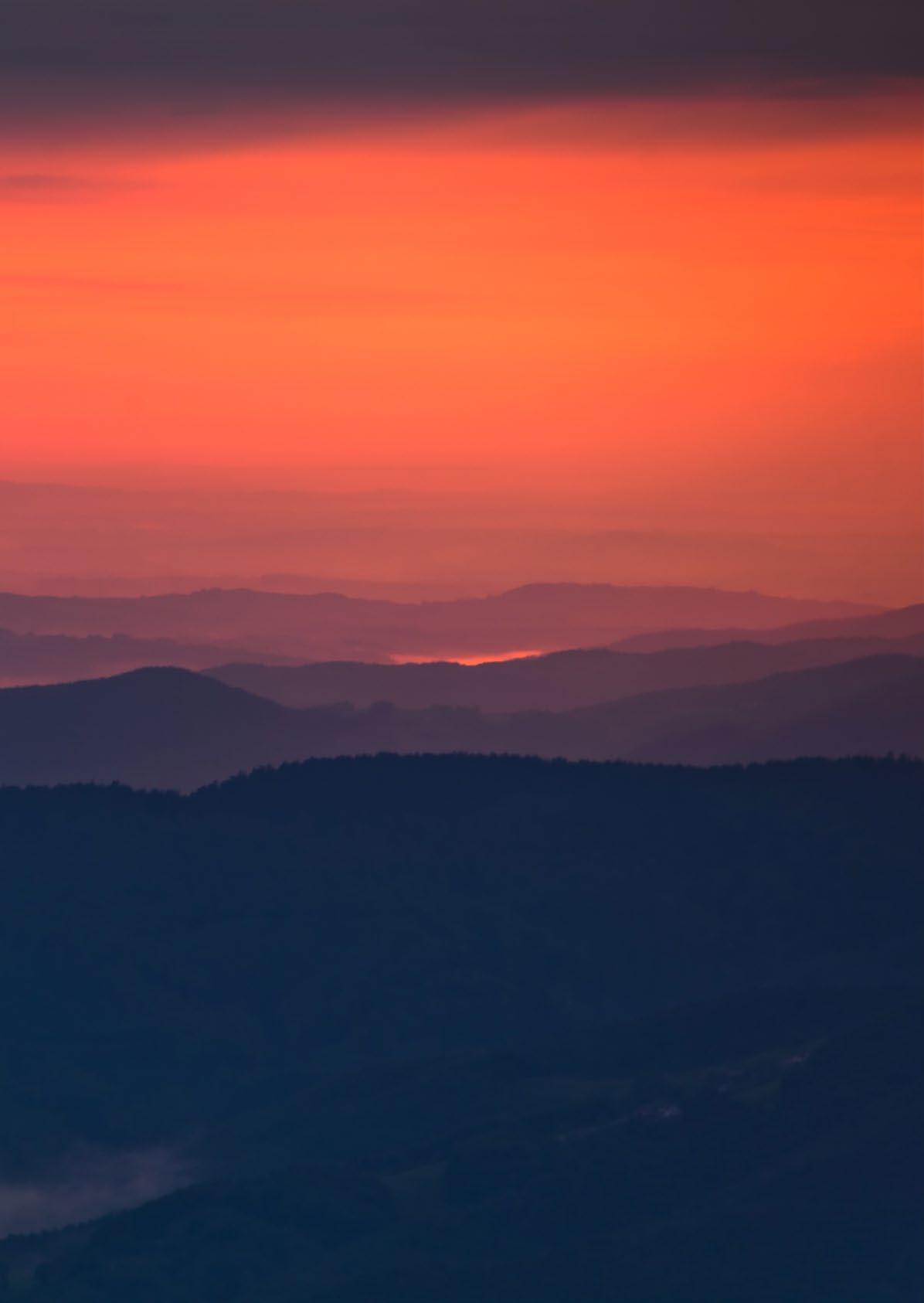
Cracow Swoszowice Czarny Dunajec Piwniczna-Zdrój Szczawnica Rabka-Zdrój Muszyna Krynica-Zdrój Uście Gorlickie
5
Geography/location
Villages among mountain tops
Piwniczna is a typical mountain commune. Piwniczna-Zdrój, a spa located by the Poprad River and the Czercz Creek, constitutes its centre. The town has a few mountains within its borders: Eliaszówka (1,024 m), Niemcowa (963 m) or Kicarz (703 m). Over the valley, on the slopes villages and hamlets climb up. The commune is surrounded by two ranges of the Beskid Sądecki: from the west, the Radziejowa Range and the Jaworzyna Range from the east. From the south, the Poprad Highlands, which partially lie in Slovakia, spread.
The woods cover 65% of Piwniczna Commune. Planted fir and spruce trees predominate. Larch and beech trees are less common – they constitute relics of the Primaeval Carpathian Forest. Diverse landforms (the altitude between
357 and 1,140 m) and the richness of mountain creeks influences the wonderful climate which in some places has the features of the alpine one.
The most specific natural element of the commune is the Poprad. The river flows through its centre and the majority of villages within its borders – Głębokie, Młodów, Wierchomla Wielka and Zubrzyk. Small creeks from the Beskid Mountains flow into the Poprad – the Wierchomlanka, the Czercz, the Głęboczanka, the Jaworzyna, the Śmigowskie and the Łomniczanka. The Poprad has always been important for the region. It created the valley through which a trade route led. Today it attracts tourists – either those who want to relax on its banks or those who love sports.
 A view of the Poprad River Valley and Piwniczna-Zdrój from Kicarz
A view of the Poprad River Valley and Piwniczna-Zdrój from Kicarz
6 Piwniczna-Zdrój GEOGRAPHY/LOCATION




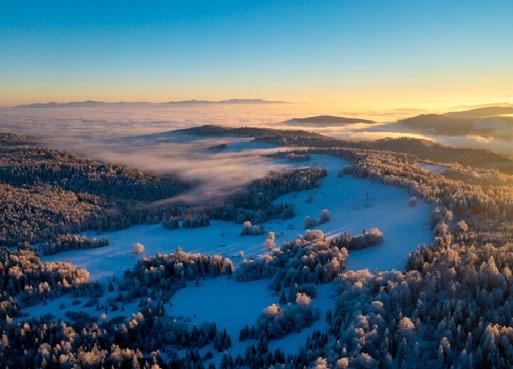
 Nearby hills, Walczaki District
The vicinity of Niemcowa in the Radziejowa Range
The panoramic tower on Eliaszówka
A view in the direction of the Tatras from Bacówka over Wierchomla
Densely forested areas of Piwniczna Commune
Nearby hills, Walczaki District
The vicinity of Niemcowa in the Radziejowa Range
The panoramic tower on Eliaszówka
A view in the direction of the Tatras from Bacówka over Wierchomla
Densely forested areas of Piwniczna Commune
1 2 4 6 5 3 7
The vicinity of Głębokie Village
THE PARK AND THE MINERAL WATER PUMP ROOM ‘AT SAINT KINGA’S SPRING’ IN GŁĘBOKIE
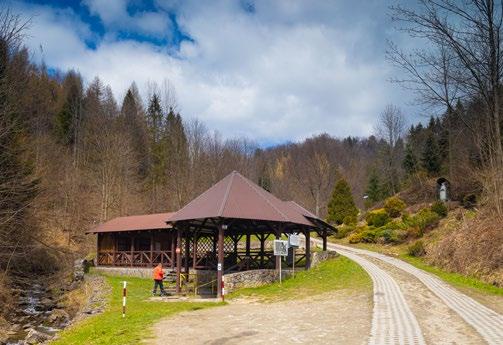
At the beginning of the 19th century a shepherd, Michał Cięciwa, discovered a spring of mineral water in the valley of the Głęboczanka Creek which cut into the Jaworzyna Krynicka Range. His discovery was confirmed by spa doctors and chemistry professors from the University of Lviv. In the second half of the 19th century the first water intake was created there. A fire in 1934 destroyed all the buildings but in 1971 new boreholes were made and the Spring of Saint Kinga was created. At present the spring is popular, one may come there, draw water to a bottle but very often people draw this healing water to bigger containers. The spring is surrounded by a park over which there is a panoramic terrace from which we can admire the Poprad Valley and the Radziejowa Range. By the paths, stones with information boards about the patron of this place are located.

NATURAL MONUMENTS OF ŁOMNICA
There are two inanimate nature monuments within the area of Łomnica-Zdrój. The first one is a waterfall on the Łomniczanka Creek with a height of 3 m. At its base, there is a plunge pool 1.6 m deep. The waterfall, the creek channel and mineral water springs create the natural monument of Zofia and Stefan Alexandrowicz established in 1982.

The second monument is a sandstone rock ‘Łomniczanka’ which is 9 m high and 3.5 m wide. On its surface, we can see structures of interesting shapes which were created in the process of weathering. ‘Łomniczanka’ was listed as an inanimate nature monument in 1988.

INTERESTING FACTS
1 2 4 3 8 Piwniczna-Zdrój INTERESTING FACTS
‘ŁOMNICKI ENCHANTED FOREST’ –A NATURE AND EDUCATIONAL PATH

Łomnica-Zdrój has one more attraction to offer. ‘Łomnicki Enchanted Forest’ – a nature and educational path was created by the Piwniczna Forest Inspectorate. The path covers a distance of 3 km where we will find 9 stops with information on the plants and animals which inhabit the Poprad Landscape Park.
THE KAZIMIERZ SOSNOWSKI MAIN BESKID TRAIL AND THE CAMINO DE SANTIAGO

Piwniczna-Zdrój is a stop for travellers and pilgrims. The Kazimierz Sosnowski Main Beskid Trail, 500 km long and marked red, runs through the town. The trail starts in Ustroń in the Silesian Beskids and finishes in Wołosate, in the Bieszczady Mountains. It runs through the most beautiful corners of the Silesian Beskids, the Żywiec Beskids, the Gorce, the Beskid Sądecki, the Low Beskids and the Bieszczady Mountains. The section of the trail in Piwniczna is almost in the centre of the whole route. Another long distance trail which runs through the commune is one of the branches of the Way of Saint James which leads to the Cathedral of Santiago de Compostela in Spain where, according to tales, the body of Saint James was buried. The first pilgrims flocked to the place in the 10th century. The trail is marked with St James’s shell and yellow arrows. We can see them on the border trail which goes through Eliaszówka.
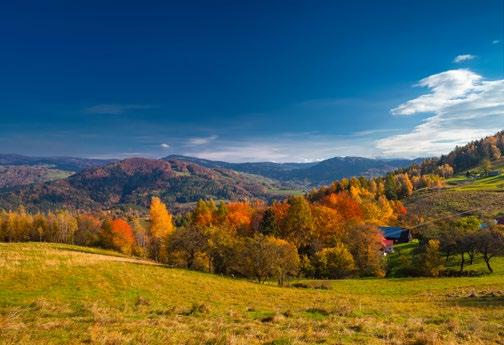

7 8
6 5 9
JACKOWA POŚCIEL – THE VALLEY OF REMEMBRANCE
A place worth visiting due to its amazing history is Jackowa Pościel. Late Grandma Nowak, called the queen of the Beskid Sądecki, lived alone below Kordowiec. A Beskid guide, Jacek Durlak, visited her house to see if everything was ok and brought her some essentials. In 2004 when he was on his way back, he collapsed and died on a clearing close to the yellow trail from Piwniczna to Niemcowa. Tourist activists and guides wanted to commemorate the place of his death and this was the reason to create Jackowa Pościel – the Valley of Remembrance. The memorial obelisk was soon accompanied by other ones. In this way the place where friends who died in the mountains are remembered was created.
HEAVENLY VIEWS FROM BACÓWKA OVER WIERCHOMLA
Bacówka over Wierchomla is a tourist PTTK (Polish Tourist Sightseeing Society) shelter located undoubtedly in one of the most panoramic places in the whole Beskid Sądecki. A lot of tourists visit the place to sit on a terrace and enjoy amazing views of the Radziejowa Range and the Tatras.
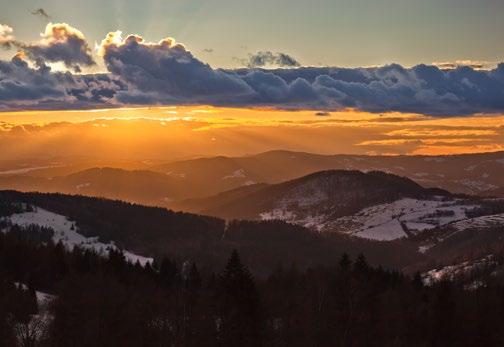
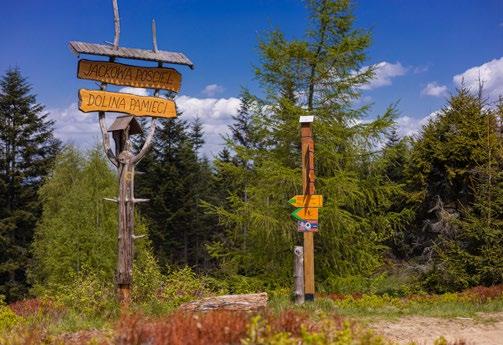
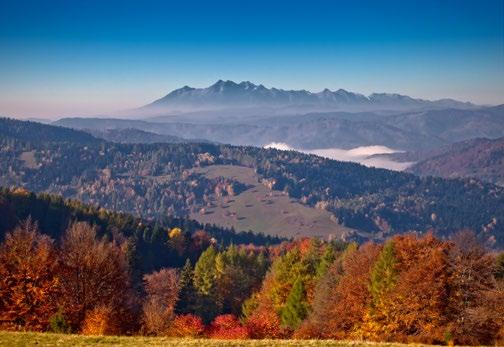

INTERESTING FACTS
1 2 4 3 10 Piwniczna-Zdrój INTERESTING FACTS
THE CAVES AT THE FOOT OF PUSTA WIELKA
Wierchomla Nature Reserve is supposed to protect the natural beech-fir forest i.e. Carpathian beech and numerous rocky outcrops of conglomerate and Magura sandstone. The landslide of these formations created caves which are not very common in the Beskid Sądecki.
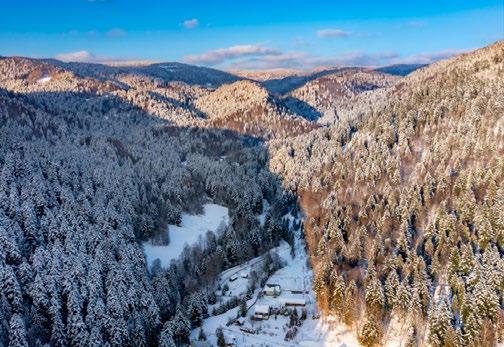



ALPS IN PIWNICZNA
Kosarzyska and Obidza are districts of Piwniczna-Zdrój which can boast of a unique climate which has alpine features. They are located in the Czercz Valley and on descending slopes. Nearby mountain tops such as Eliaszówka (1,023 m), Wielki Rogacz (1,182 m) and Niemcowa (963 m) protect these areas from the wind and also the sun. Such a landform causes significant temperature fluctuations between the valley and the peaks. Very often we may witness temperature inversion. Snow lies there for a long time and spring comes late.
7 8 6 5 11
Spa
The Beskid Sądecki is famous for its mineral waters which flow out from the earth’s interior. They owe their valuable properties to the rocks of Magura nappe which saturates underground water with minerals.
At the end of the 19th century a doctor from Lviv, dr Juliusz Korwin Gąsiorowski, discovered springs of mineral water with healing properties in Piwniczna. However, the first boreholes were made in 1932. This event gave a new character to Piwniczna – it became a spa and relaxation centre which was known nationwide. The bottled water started to be sold outside the town. Piwniczna-Zdrój is currently one out of nine resorts in Nowy Sącz Poviat acknowledged by the Minister of Health.

The Spa Park and the Mineral Water Pump Room were created for health visitors who want to try mineral water
from Piwniczna. The pump room has become the centre of various cultural events as the Artistic Pump Room. In the park there is an amphitheatre great for outdoor concerts, charming alleys ideal for peaceful walks and a playground for children.
The beginning of the 20th century is connected with the development of the second resort in the commune, namely, Łomnica. The first records about its mineral waters are from 1910. Doctor Ziarko in his villa created a bathing house where one could have a mineral or peat bath. However, the place was destroyed by a flood which struck Łomnica in 1939 and it has never been rebuilt.
Today the spring ‘Stefan’ lined with a stone underpinning flows out from a slope over the village. Everyone can go there and try Łomniczanka mineral water.
The mineral water pump room in Zawodzie
The underground treasure 12 Piwniczna-Zdrój SPA
What can be treated there?
Local mineral waters, called ‘sour’ by the locals, are distinguished by a high content of magnesium and calcium bicarbonate. Thanks to them mineral waters are of great assistance in the treatment of:


peptic ulcer disease, inflammatory conditions of the intestines and pancreas, inflammatory conditions, diabetes, diseases of the respiratory tract : bronchitis, emphysema and pneumoconiosis.
What treatments?
Relaxation and treatment centres or sanatoria offer a wide selection of therapies and treatments with the use of mineral water. Mineral water baths, hydro massages and peat treatments are very popular among health visitors.
Inhalations have a beneficial influence on the respiratory tract. Krenotheraphy i.e. water drinking therapy is also implemented there.
The location of mineral water pump rooms and springs
PiwnicznaZdrój Mníšek nad Popradom Wierchomla Wielka Wierchomla Mała ŁomnicaZdrój Kokuszka Pusta Wielk 1061 Parchowatka 1005 J Łaziska 941 Lem 893 Przypór 887 Wierch (Łazek) 842 Kiczera 840 Kiczora 806 Rąbaniska 786 Kiczora 763 Drapa 717 Granice 715 706 Kicarz 704 688 610 Szycówka 595 Dermanowski Wierch (Bystra) 562 Mały Kicarz 68 87 971 Krakowska K r yn ck a Krynicka Krynicka PopradzkiPark K r a j o ywozarb Park Krajobrazowy Pop r da Poprad Poprad Łomniczanka Piwniczanka St Kinga’s spring in Głębokie Stefan ‘Wierchomlanka’ spring Hanna ‘Źródło’ spring in Wierchomla
13
Mineral waters present in the area of Piwniczna-Zdrój Commune can be found in pump rooms or directly at places where they flow out – from the ground or a rock.
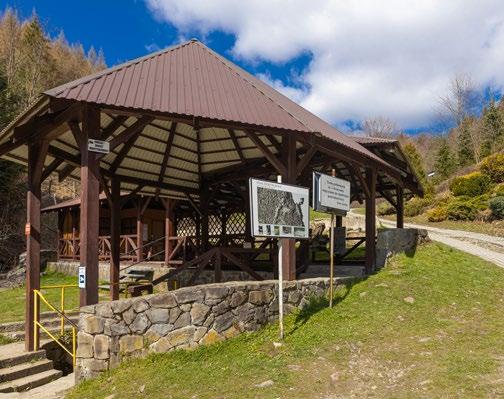

'PIWNICZANKA' is acidulous bicarbonate water rich in magnesium and calcium. It is helpful when you need to strengthen your bones, improve the absorption of iron and enhance metabolism. It has anti-allergic properties, positively influences the functioning of the vascular and nervous system.
'HANNA' in Wierchomla Wielka is acidulous sodium bicarbonate water rich in magnesium and calcium. Carbon dioxide adds to its healing properties. It is recommended in the case of high blood pressure, limb ischemia due to atherosclerosis or diabetes and functional heart diseases.
THE SPRING OF SAINT KINGA IN GŁĘBOKIE is acidulous sodium bicarbonate water rich in magnesium and calcium. It is of great assistance in the treatment of peptic ulcer disease, constipation, gout, diabetes, kidney stones and anaemia.

Spa attractions/curiosities of the commune
14 Piwniczna-Zdrój SPA
‘STEFAN’ IN ŁOMNICA-ZDRÓJ is acidulous bicarbonate water rich in magnesium and calcium. It is recommended in the case of chronic conditions of the digestive system and constipation.
'ŁOMNICZANKA' in Łomnica-Zdrój is acidulous bicarbonate water rich in magnesium and calcium. It is recommended in the case of chronic inflammatory conditions of the digestive system and constipation.
'ZDRÓJ' IN WIERCHOMLA is acidulous bicarbonate water rich in magnesium, calcium and sulphide. The water from this spring is of great assistance in the case of chronic inflammatory conditions of the respiratory tract, the digestive tract, metabolic disorders and metal poisoning.


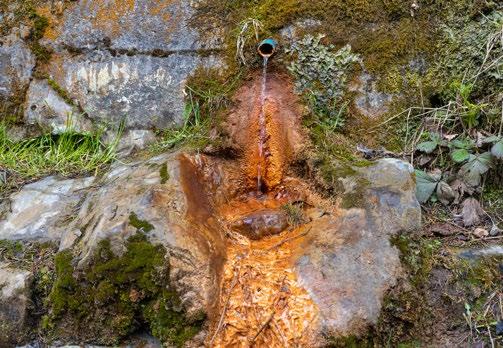
‘WIERCHOMLANKA’ IN WIERCHOMLA is acidulous bicarbonate water rich in magnesium and calcium. It is helpful in the treatment of peptic ulcer disease, chronic cholecystitis, constipation, gout, diabetes, kidney stones and anaemia.

15
History in a nutshell
Łomnica-Zdrój is one of the oldest villages in the vicinity. The first records say that it was established earlier than Piwniczna-Zdrój on the site of a former village. It was established by Casimir III the Great, hence, it was a royal village. Its name is connected with the king. The king was supposed to force his way through łoms (i.e. broken trees) to get there. Such a broken tree was placed in the emblem of the village next to a jug and a tap which symbolise a spa. Another hypothesis says that the name comes from a rapid stream which broke (break – łamać in Polish) rocks.
Brave people of Łomnica

In 1410 when the famous Battle of Grunwald took place, Sądecki Land had to face its own problems. Taking advantage of the fact that all the knighthood moved into the attack in the north, the army of Zygmunt Luksemburczyk under Ścibor from Ściborzyc command attacked Sądecczyzna. The unprotected land was supposed to be an easy win. However, the invaders met resistance from those who remained in their houses – peasants. Levy en masse of the peasants from Łomnica and Piwniczna forced the army of Luksemburczyk to the areas of today’s Slovakia where they were completely defeated.

1200 1300 1348
1400 1500
r.
1600
The Royal Free Town of Piwniczna was established by Casimir III the Great in cruda radice i.e. in a place where no settlement had previously existed.
Casimir III the Great and his difficulties on the way to Łomnica
16 Piwniczna-Zdrój HISTORY IN A NUTSHELL
Idyllic scenery over Łomnica
Through a narrow gorge to Piwniczna
The name ‘Piwniczna Neck’ which has functioned since the 18th century came from a narrow gorge of the Poprad River which was located in the vicinity of today’s hamlet – Międzybrodzie. The name Piwniczna comes from the entrance to the town from its north side shadowed by a dense forest (like a basement – piwnica in Polish). However, there is another explanation for this name. Folk legends say the town and its vicinity housed early mediaeval dungeons or tunnels which served as a hiding place of the local community. But where is the entrance to these dungeons and tunnels? It is said that it was placed under the old school where a little park is located.
War guides, couriers and liaisons

The inhabitants of the borderland who before the Second World War had earned their living trading or smuggling goods from Slovakia after its outbreak became guides who led escapees across the border. After 1939 people used the present trails to run away from the invader to the west, to flock to France in order to join the army which was being created there or get to Budapest where the Armed Forces General Command had its headquarters. Eliaszówka (1,023 m) located on the border with Slovakia was one of the most commonly chosen places where the border was crossed.
Today, there is a plaque which commemorates the trail of war couriers, liaisons, guides and those who gave them shelter.
Numerous groups of partisans supported by local people were active in Piwniczna. During the invasion, the Nazi committed mass murders four times in this area. The monuments which commemorate those events are located in Kosarzyska, Łomnickie and Młodów. Piwniczna-Zdrój was honoured with the Cross of Valour in 1986.
The Bard of the Lemko Region in Wierchomla Wielka
Piwniczna Commune was on the border of two cultures: the Polish and Lemko one. The person worth mentioning in this matter is Wołodymyr Chylak. This priest was born in Wierchomla Wielka in 1843. Today he is regarded as the most significant Lemko writer of the second half of the 19th century. In his stories, articles and essays he touches upon topics of Lemko culture and history and also social problems of this group contributing to the creation of Lemko identity.
1801 r 1876 r. 1884 r. 1880
1931
1876 r 1600 1700
r.
r.
‘Kasta’ i.e. a tank which was a tank for water supply was built.
A fire consumed a wooden church and forty houses. The aforementioned kasta also burnt down. Solely the figure of Saint Florian survived as it fell into the water.
First health visitors came to Pwiniczna.
The town was granted a spa status.
1800
A railway line on the MuszynaNowy Sącz route was launched.
The 18th and 19th century
The town located on a trade route which led to Hungary developed at a fast pace. The water supply network was created in the 18th century and at the turn of the 19th century a school, an inn, five mills, a brewery and a hospital were constructed.
2000
A doctor from Lviv, Korwin Gąsiorowski, discovered that local waters have healing properties.
1900
1908 r.
A train stop was finally established in Piwniczna.
Guerilla war in Piwniczna
17
Thanks to Towarzystwo Miłośników Piwnicznej (the Association of Piwniczna Enthusiasts) the Regional Museum was founded in 1978 in the Communal Culture Centre. There are everyday objects made by Black Highlanders and equipment which comes from old shoemaker’s, weaving, cooper’s, furrier’s or wheeler’s workshops. The objects are meticulously made and decorated with beautiful, folk patterns. Moreover, the museum displays the traditional outfit of Black Highlanders. One of the most interesting exhibitions in the museum is the one presenting skiing
equipment. Professor Zbigniew Bielczyk had collected it for many years and donated it to the museum. You will see skis from various European countries – the oldest ones are from the 18th century. You may also follow through the whole history of skiing, which is almost 5,000 years old, presented on colourful boards. There are also ‘young’ exhibits such as a ski donated by Adam Małysz which stands next to Stanisław Marusarz’s ski who was our first champion of ski-jumping. The collection has 300 exhibits
The panoramic spot with a historical background
In the vicinity of Wierchomla Mała, in the direction of Pusta Wielka there are a few clearings – Wyżne Młaki, Długie Młaki, Polana Gwiaździsta (the Starry Clearing), Polana nad Wierchomlą (the Clearing over Wierchomla). Breathtaking views spread from them but also the area is connected with an interesting history. They are a reminder

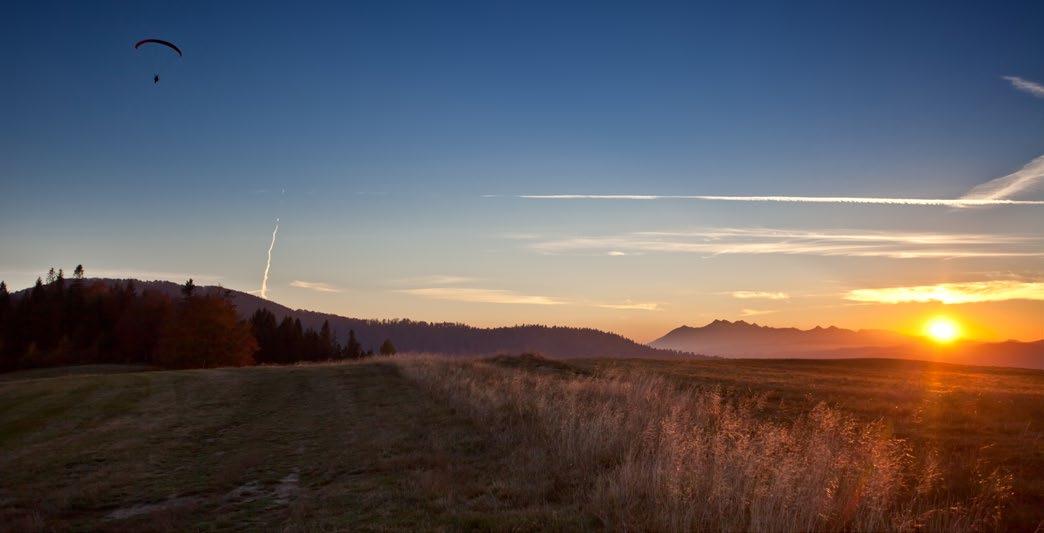
of the former life and work of Lemko people. After they had been resettled, the clearings were taken over by the Polish thanks to whom they did not overgrow. Nowadays you will find ski slopes there whose names relate to Lemko surnames of the former inhabitants of this land – ‘Toczek’, ‘Fiedor’, ‘Płatek’ and ‘Frycek’.

18 Piwniczna-Zdrój HISTORY IN A NUTSHELL
The history of skiing collected in the Museum of Piwniczna-Zdrój
Piwniczna-Zdrój
The town on a trail

Piwniczna-Zdrój is a small mountain town located in the Poprad Valley and on the slopes of nearby mountains. The south border of the town is marked by the border of Poland. The settlements spread to the height between 357 m and 1,140 m and are inhabited by almost 6,000 people. The town comprises the areas above the settlements including mountain tops and panoramic meadows.
The beginning of Piwniczna-Zdrój dates back to the 14th century and the times of Casimir III the Great who established it to protect the trade route from Hungary in the direction of Cracow. For many years the town had been developing thanks to passing by merchants. Although we can


see Hungarian influences in the traditions of Piwniczna until today, the culture of Black Highlanders reigns there.
The centre of Piwniczna-Zdrój has a high-density pattern with a regular, historic square and numerous hamlets which can be associated with villages rather than with a town. There are historic buildings including an interesting building of the Regional Museum and a reconstruction of an old water tank on the square. Węgielnik (498 m) on the top of which there is a panoramic terrace reigns over the town. From it a view of the Poprad, the Czercz and the town stretches.
1 3
2
The historic train station is located on the very route
‘Pijalnia Artystyczna’ is a climatic place on a trail
19
A view of the meandering Poprad and Piwniczna-Zdrój which lies on its banks
The Square with a well in Piwniczna-Zdrój
The four-sided Square and the streets which lead from its corners reflect the town plan established in the 14th century when Piwniczna was founded. The town hall, which dates back to the 19th century, at first served as a stronghold and currently is the seat of local authorities. One of the most interesting attractions of the Square is a well. And
Orlęta Guest House
This is the second, after the buildings in the Square, a historic site registered by the National Institute of Cultural Heritage. It is located at 2 Gąsiorowski Street. It was built in 1897 as a half-timbered construction whose wooden frame is filled with a mixture of straw, clay and wooden shred or bricks. Such buildings are popular in the region of the Alps. In the Middle Ages they were also erected in central and southern Poland. Now, they are rare and constitute a real treat for enthusiasts of old architecture.

what is interesting about it? There used to stand a so-called ‘kasta’ i.e. a water tank which supplied water to the town. Unfortunately the fire of 1876 consumed the tank with a part of buildings. The figure of Saint Florian which fell into the water survived. At present there is a reconstruction of a well from 1913 and in its turret Saint Florian stands.
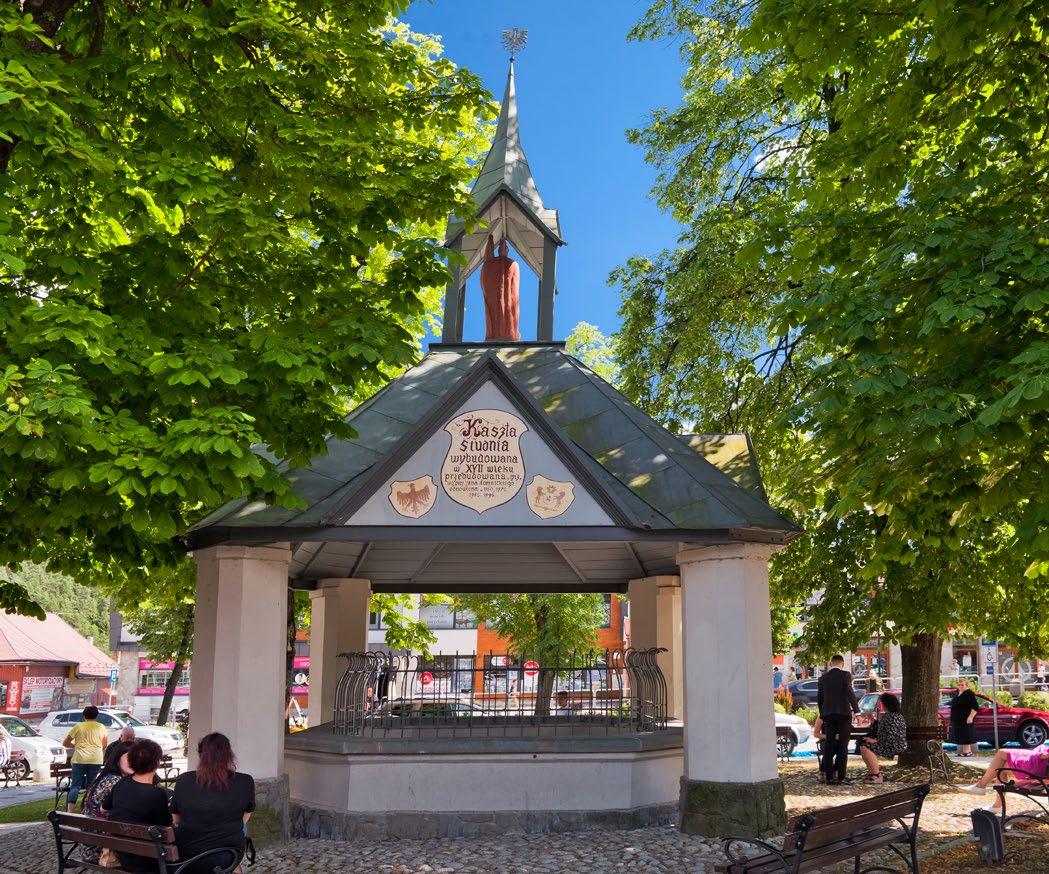
1 2
20 Piwniczna-Zdrój PIWNICZNA-ZDRÓJ
Węgielnik–Rocks Park
It is one of more compelling attractions within the town. It was created on a previously inaccessible hill, Węgielnik (498 m). At the foot of the park there is a statue of the Virgin Mary with a mineral water spring flowing at her feet and a monument which commemorates the Battle of Grunwald. The park is a maze of either gentle or a little more difficult, with safety chains, tourist trails which lead to a panoramic platform from which we can admire the southern part of the town and the Ľubovnianska Vrchovina. While walking along the paths, we can admire rock outcrops or reconstructed war trenches from the Second World War. Information boards tell a story of the place – local people built wooden trenches on the orders of the Nazi who feared Soviet invasion. The park abounds in sports and recreation facilities, barbecue sites, a gazebo, a volleyball court, weight training equipment and a playground.
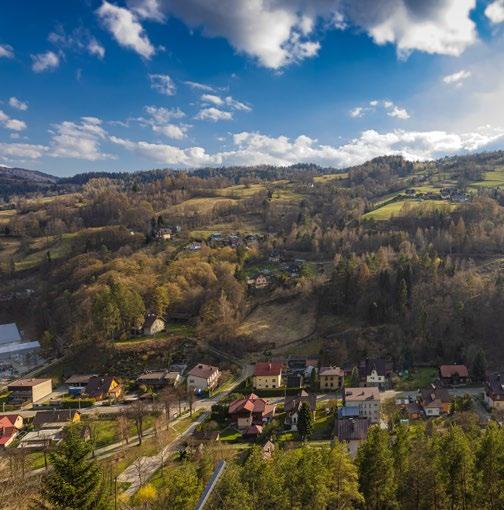
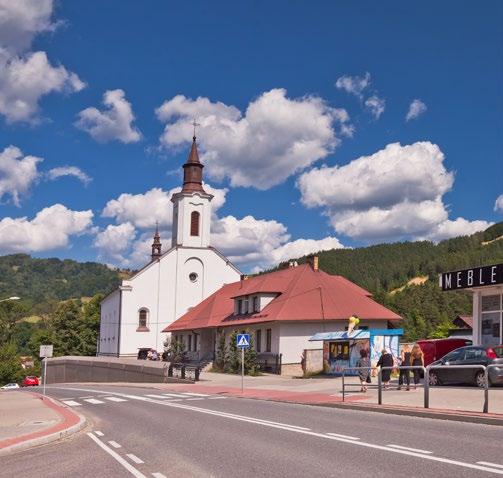
The Church of the Nativity of Holy Virgin Mary
The parish church located in the Square was built in the years 1881 – 1886 on the site of old temples. It is a neo-Baroque basilica. The tower and the bell are much older – they date back to 1523. In the chancel we may admire a painting ‘Saint Joseph with the Infant Jesus’ by Bolesław Barbacki –a painter and a social activist who came from Nowy Sącz.
Czercz Waterfall
A waterfall on the Czercz Creek is located in Kosarzyska which is a district of Piwniczna-Zdrój. It is small but charmingly located on the edge of a forest. Water goes down a wide, 4 metre high wall made of stone blocks. During the Second World War the trail of war couriers ran through this place.

5 3
4
21
A view from a panoramic tower
Villages by the Poprad river
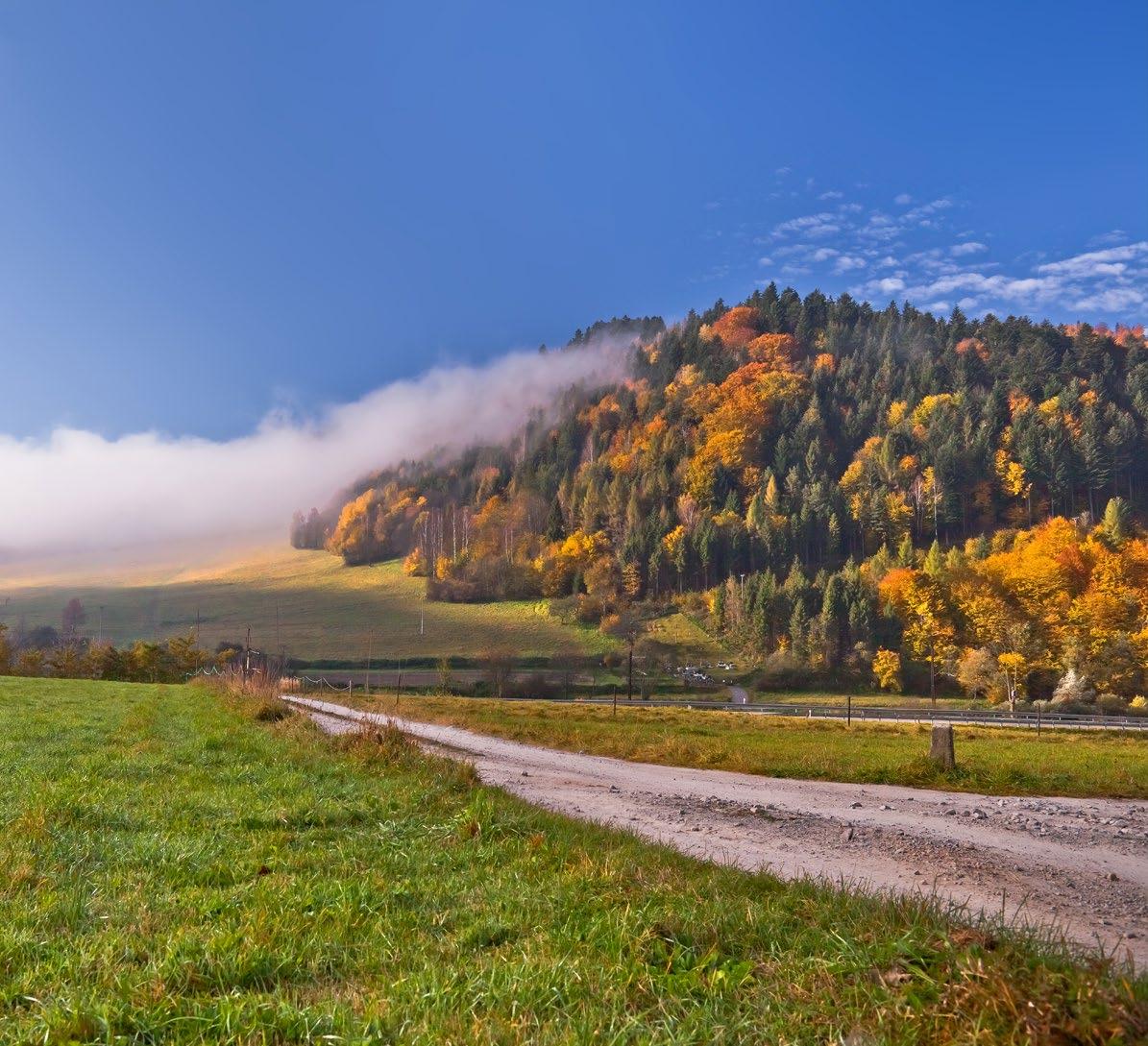
In the mountains, in the valleys…
The whole Piwniczna Commune is strongly connected with the Poprad River. The villages of the commune are located on its banks or on the slopes which descend to the valley of the river.
Some of them such as Łomnica-Zdrój, Głębokie or Wierchomla Wielka can be proud of mineral water which springs up from the Earth’s interior. There are also villages which are worth visiting due to their well-preserved wooden architecture characteristic for the Beskid Sądecki such as Kokuszka. Apart from wooden cottages, you will find old mills there. Places such as Łomnica-Zdrój preserve
intangible cultural heritage of Poprad Highlanders such as Łomnicański dialect or dumplings. There is also a folk band called after the delicacy of the region ‘Piyrogi Łomnicońskie’ (Łomnicańskie Dumplings). If you want to familiarise yourself with the history of Lemko people who had inhabited this area until they were resettled, you need to visit Wierchomla Wielka, Wierchomla Mała and Zubrzyk. Additionally, the villages offer plenty of tourist trails which will guide tourists hungry for mountains to the tops of the Radziejowa and the Jaworzyna Range, to the Ľubovnianska Vrchovina and further into the Low Beskids and the Pieniny.
A dirt road in Zubrzyk 22 Piwniczna-Zdrój VILLAGES BY THE POPRAD RIVER
Piwniczna-Zdrój is based on traditions
Folk traditions of Black Highlanders are still living in Piwniczna-Zdrój. At present, we can admire there traditional wooden (spruce or fir) houses based on stone underpinnings very often of irregular shapes accustomed to steep slopes. The land is still cultivated and sheep are still grazed in this area either all year round in the valleys or seasonally – on mountain clearings.
The name ‘Black Highlanders’ comes from the colour of a man’s costume in which dark brown or, less often, black prevailed which made Black Highlanders stand out from other ones.
Songs which were sung while grazing sheep or cattle, wedding tunes or rhythmic melodies suitable for dancing can be heard at present as music traditions of Black Highlanders are preserved by ‘Dolina Popradu’ (Poprad Valley) – a folk band. The band was established in 1965 and since 1988 poems written by Wanda Łomnicka-Dulak, a poet and a member of the band, have been sung by
them. The band has performed all over the world and has won numerous awards. A group of musicians who play the heligonka is active in this area too. The heligonka is a traditional instrument which resembles a smaller accordion with buttons instead of a keyboard, popular in the south of Poland, Czechia and Slovakia.
Łomnicańskie dumplings
Łomnica-Zdrój is famous for Łomnicańskie dumplings. You make them from grated potatoes and fill them with boiled potatoes and bryndza (sheep cheese). They have been listed as a traditional product by the Ministry of Agriculture and Rural Development. The dumplings are legendary among Black Highlanders not only because of their taste but also size. One of the legends says that when such a dumpling fell from a table, it killed a hen and its five chicks. The other one claims that when the Poprad flooded Piwniczna, people used hollowed dumplings as boats.
THE ORTHODOX CHURCH OF ST MICHAEL THE ARCHANGEL IN WIERCHOMLA WIELKA
This Greek Catholic church was erected in 1821. Its construction serves as a typical example of Lemko architecture. Inside we will find the baroque-classical polychromy from 1928. After the ‘Vistula’ Operation in 1947 the church was taken over by the Roman Catholic Parish of St Michael the Archangel. Since 1964 it has been a historic site and it has become a site of the Wooden Architecture Route.
TRADITIONAL WOODEN ARCHITECTURE
We can admire traditional, wooden, old cottages characteristic of Sądecki Land in Kokuszka. There are also remains of water mills from the Interwar Period.
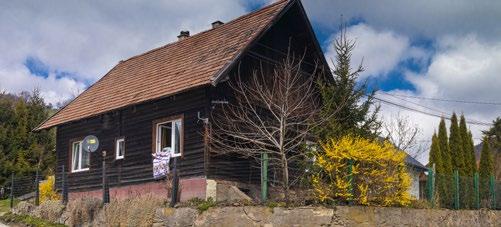


THE SHRINE IN A ROCK
Being in Wierchomla Wielka, it is worth going for a walk along the valley of Potasznia which used to be inhabited by Lemko people. On this route, close to the road leading to Wierchomla Mała, we will come across a magnificent block of sandstone which, when we look at it closely, turns out to be a shrine with an image of Crucified Christ. The date of its construction, 1841, is well-visible on the shrine. Going further, we can step into ‘Lembarczek’ Nature Reserve, later reach Kobylarz which is a nature monument and finally get to a place ideal for rest – a wooden shelter called ‘Pod Hale’.
1 2 3 23
Commune in an active way
Mountain trails
Piwniczna-Zdrój, the commune and the town, offers marked hiking, cycling trails or bridle and health paths. The Kazimierz Sosnowski Main Beskid Trail and the Camino de Santiago, which leads to Santiago de Compostela in Spain, cross Piwniczna-Zdrój.

The yellow trail from Piwniczna to Hala Pisana (1,044 m), from there to Frycowa (a panoramic section). On Hala Pisana we can change the trail into the red one in order to reach Hala Łabowska (1,021 m). We come back to Piwniczna along the blue trail.
The yellow trail from Piwniczna also leads in the direction of the Radziejowa Range, to Niemcowa (977 m). Although the trail ends on Niemcowa, we may continue our trip along the Main Beskid Trail to Wielki Rogacz (1,142 m), Radziejowa (1,262 m) and the PTTK (Polish Tourist and Sightseeing Society) Shelter on Przehyba (1,138 m). From there, following the blue trail we descend to Rytro.
The red trail from Piwniczna through the Czercz Valley to the Gromadzka Pass (908 m). At the place, we can change the trail into the green one in order to reach Piwniczna-Zdrój passing by Eliaszówka (1,023 m) or get to Wielki Rogacz (1,182 m). The red trail from Piwniczna-Zdrój leads us from the Gromadzka Pass to a panoramic trail through Ruski Wierch (935 m) to Jaworki in the Pieniny.

24 Piwniczna-Zdrój COMMUNE IN AN ACTIVE WAY
The green trail from Piwniczna leads along the border with Slovakia through Eliaszówka (1,023 m) to Gromadzka Pass (908 m).
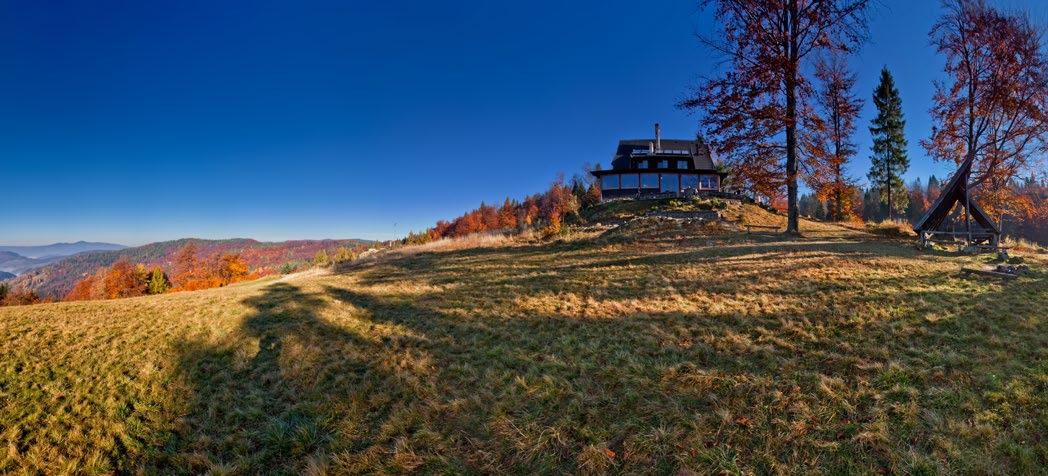

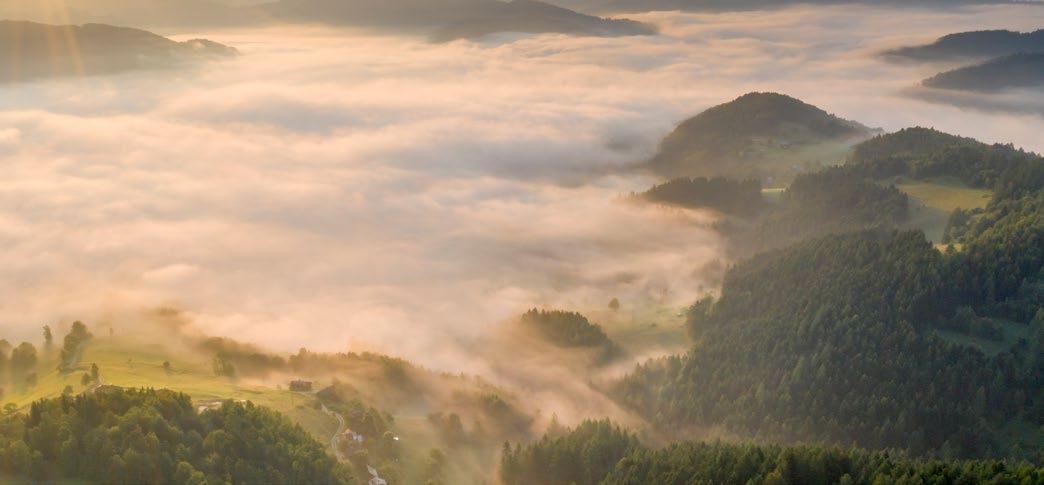
The black trail from Wierchomla Mała leads to Bacówka over Wierchomla (883 m) and further to Runek (1,080 m) or Pusta Wielka (1,061 m).
The blue trail from Łomnica-Zdrój to Hala Łabowska (1,021 m) leads to a famous though difficult path of ‘77 bends’. We can descend to Łomnica by the yellow trail through Parchowatka (1,005 m).
25
1 Rafting through the Poprad Valley
If we go rafting on the Poprad from Piwniczna to Rytro, we cover a distance of 10 km. Such a trip will take us from 1.5 to 2.5h. Rafting season lasts from April to October but it can be changed depending on the weather. Rafting by the Poprad is a real treat for both children and adults and the route abounds in beautiful views.

2 Quad rentals
For adventure enthusiasts an off-road ride along a roadless tract in the Beskid Sądecki would be a real treat. Quad rentals in Piwniczna offer quads, snow scooters, off-road vehicles and organise enduro rides.
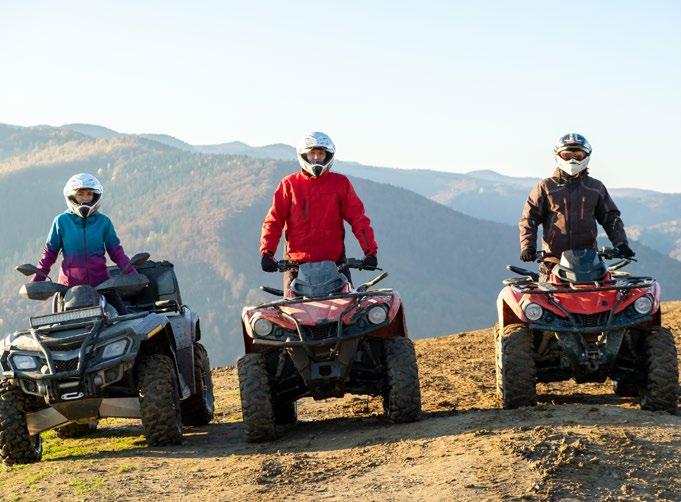
3 Mountain and electric bikes rental
A few bike rentals, which also offer a possibility of delivering their equipment to a customer, operate in Piwniczna-Zdrój and Wierchomla Mała. Obviously, you can also rent helmets and other accessories or take advantage of organised bicycle tours into the mountains.
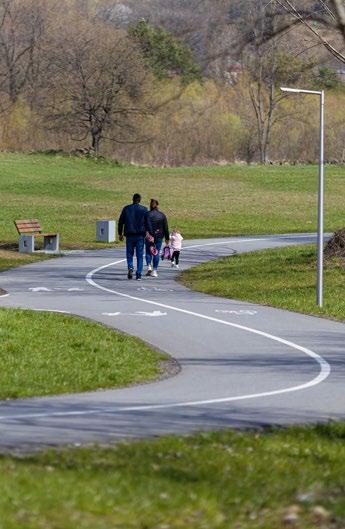
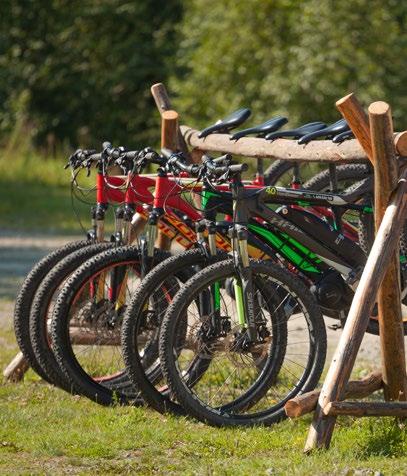
4 Fishing on the Poprad
On the section between Leluchów and Piwniczna-Zdrój the Poprad is a truly mountainous river, it has winding bends and a rocky bottom with tunnels and riffles. There are 25 species of fish such as the common chub, the river trout, the grayling, the common dace, the common barbel, the barbus, the common roach, the common bleak, the common perch, the common nase, the common minnow, the European bullhead or the gudgeon. The rainbow trout,
1 2 3 5 26 Piwniczna-Zdrój COMMUNE IN AN ACTIVE WAY
the brook trout, the brown trout and even the huchen are present but less common.

5 A pump track, a skatepark and hiking and cycling trails
The attractions in Nakło, which have been opened recently, are popular among the active ones. You will find workout facilities, bike rental and a service point ‘Rowerowa Dolina’ (Cycling Valley) at the place. The area is connected by a footbridge with the spa part of the town. Showers and toilets are available to visitors too.

6 Horse riding
There are two horse riding centres in Piwniczna-Zdrój. Maślanka’s Horse Riding Centre in Łomnickie is highly respected by its visitors. Magura’s Hut Horse Riding Centre
located high in the mountains promotes the natural approach to horses and understanding their needs.

7 Baseny na Radwanowie
There is a large outdoor swimming pool with three lanes, a bath with a hydromassage, a sauna and a paddling pool for children. It is a perfect place for a relaxing stay.
8 Sports and entertainment arena in Piwniczna-Zdrój
This is a modern complex which comprises a playing field (20 x 40 m) and a stand with 230 seats. Dance training or fitness classes can take place in a specially prepared room. The facility offers a gym or a climbing wall which is 15 m high. The building can house local events, international sports competitions, cultural events and various performances.

4 6 7 8 27
By bike
Piwniczna Commune is a place through which national and international cycling trails run. The infrastructure of the trails is constantly being developed and has many sections which are completely cut off from road traffic.
VeloNatura is a part of EuroVelo cycling route (271 km) in Lesser Poland. The trail leads through the valleys of the Poprad and the Dunajec. The picturesque trail along the Poprad runs through Barcice, Rytro, Młodów, Piwniczna-Zdrój, Żegiestów and Muszyna. Its southern section was made within European Cross-Border Cooperation. Crossing the Poprad with the use of footbridges we may ride on the Polish and Slovak side.


Aquavelo project is the first step to make the area recognisable on the map of Europe as exceptional in terms of tourism, health, nature, landscape, architecture and culture. The path links such resorts as Krynica-Zdrój, Muszyna, Piwniczna-Zdrój, Szczawnica, Vyšné Ružbachy, Stará Ľubovňa, Ľubovnianske Kúpele and Bardejov.
Actively in winter
KOKUSZKA SKI STATION
Kokuszka Ski is a small ski station located in a tiny village close to Piwniczna at a height of 530 m. There are two platter lifts and one carpet lift intended for the youngest skiers. There is a ski and snowboard equipment rental and a service point. You will be able to stay there overnight, have a meal or organise a campfire.
 VeloNatura
Aquavelo
VeloNatura
Aquavelo
1 2 3 28 Piwniczna-Zdrój DZIAŁ COMMUNE IN AN ACTIVE WAY ACTIVELY IN WINTER
WIERCHOMLA SKI STATION

Wierchomla Ski Station is situated at a height of 590 – 896 m in Wierchomla Mała. Five runs of various difficulty and length (from 110 m to 1,800 m) await winter fun enthusiasts. At the upper station you can go on a cross-country skiing trail which leads to Bacówka over Wierchomla. Skiers and snowboarders have a chairlift and three platter lifts at their disposal. Freeriders will definitely enjoy a snow park for sure.
Ski touring and cross-country skiing


It is an easy route along the ridge leading from the upper ski station Wierchomla I to Bacówka over Wierchomla (883 m). On our way back we can take the same route or return along a gravel road to Szczawnik.
The trail starts in Kosarzyska in front of the church. Initially we go along the green cycling trail in the direction of Niemcowa (977 m). Later we choose the red hiking and skiing one at Wielki Rogacz. We go along the blue skiing trail to Eliaszówka and further along the blue trail too, we go down to Piwniczna.
ICE RINK
At Radwanów, right by the Poprad River, there is a swimming pool which transforms into an ice rink in winter. This is the only attraction of this type in the commune where you can safely ice skate on well-prepared ice. There is an equipment rental by the rink.
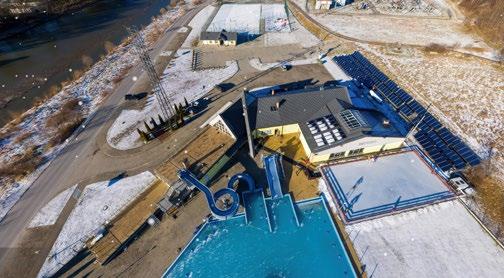
Address: Łomnickie 85, 33-350 Piwniczna-Zdrój
Phone: +48 18 442 32 08
basenyradwanow.piwniczna.pl
Wierchomla – Bacówka over Wierchomla - Wierchomla 4 km
Kosarzyska – Wielki Rogacz (1,142 m) – Eliaszówka (1 021 m) – Piwniczna-Zdrój 23 km
4 5 6 7 29 29
The project ‘The support of small and medium-sized enterprises which operate in tourism and increasing the recognisability of Lesser Poland as a tourist economic brand’ (no RPMP.03.03.01-12-0593/18) co-funded by the European Union as a part of the Regional Operational Programme of Lesser Poland for the years 2014 – 2020.

the Foundation for the Development of Regions www.f-rr.org

the Association of Polish Spa Communities www.sgurp.pl

 The project is co-funded by the Regional Operational Programme of Lesser Poland for the years 2014 – 2020. The support of small and medium-sized enterprises which operate in tourism and increasing the recognisability of Lesser Poland as a tourist economic brand.
The project is co-funded by the Regional Operational Programme of Lesser Poland for the years 2014 – 2020. The support of small and medium-sized enterprises which operate in tourism and increasing the recognisability of Lesser Poland as a tourist economic brand.




 The project is co-funded by the Regional Operational Programme of Lesser Poland for the years 2014 – 2020. The support of small and medium-sized enterprises which operate in tourism and increasing the recognisability of Lesser Poland as a tourist economic brand.
The project is co-funded by the Regional Operational Programme of Lesser Poland for the years 2014 – 2020. The support of small and medium-sized enterprises which operate in tourism and increasing the recognisability of Lesser Poland as a tourist economic brand.











 A view of the Poprad River Valley and Piwniczna-Zdrój from Kicarz
A view of the Poprad River Valley and Piwniczna-Zdrój from Kicarz





 Nearby hills, Walczaki District
The vicinity of Niemcowa in the Radziejowa Range
The panoramic tower on Eliaszówka
A view in the direction of the Tatras from Bacówka over Wierchomla
Densely forested areas of Piwniczna Commune
Nearby hills, Walczaki District
The vicinity of Niemcowa in the Radziejowa Range
The panoramic tower on Eliaszówka
A view in the direction of the Tatras from Bacówka over Wierchomla
Densely forested areas of Piwniczna Commune



























































 VeloNatura
Aquavelo
VeloNatura
Aquavelo




 The project is co-funded by the Regional Operational Programme of Lesser Poland for the years 2014 – 2020. The support of small and medium-sized enterprises which operate in tourism and increasing the recognisability of Lesser Poland as a tourist economic brand.
The project is co-funded by the Regional Operational Programme of Lesser Poland for the years 2014 – 2020. The support of small and medium-sized enterprises which operate in tourism and increasing the recognisability of Lesser Poland as a tourist economic brand.